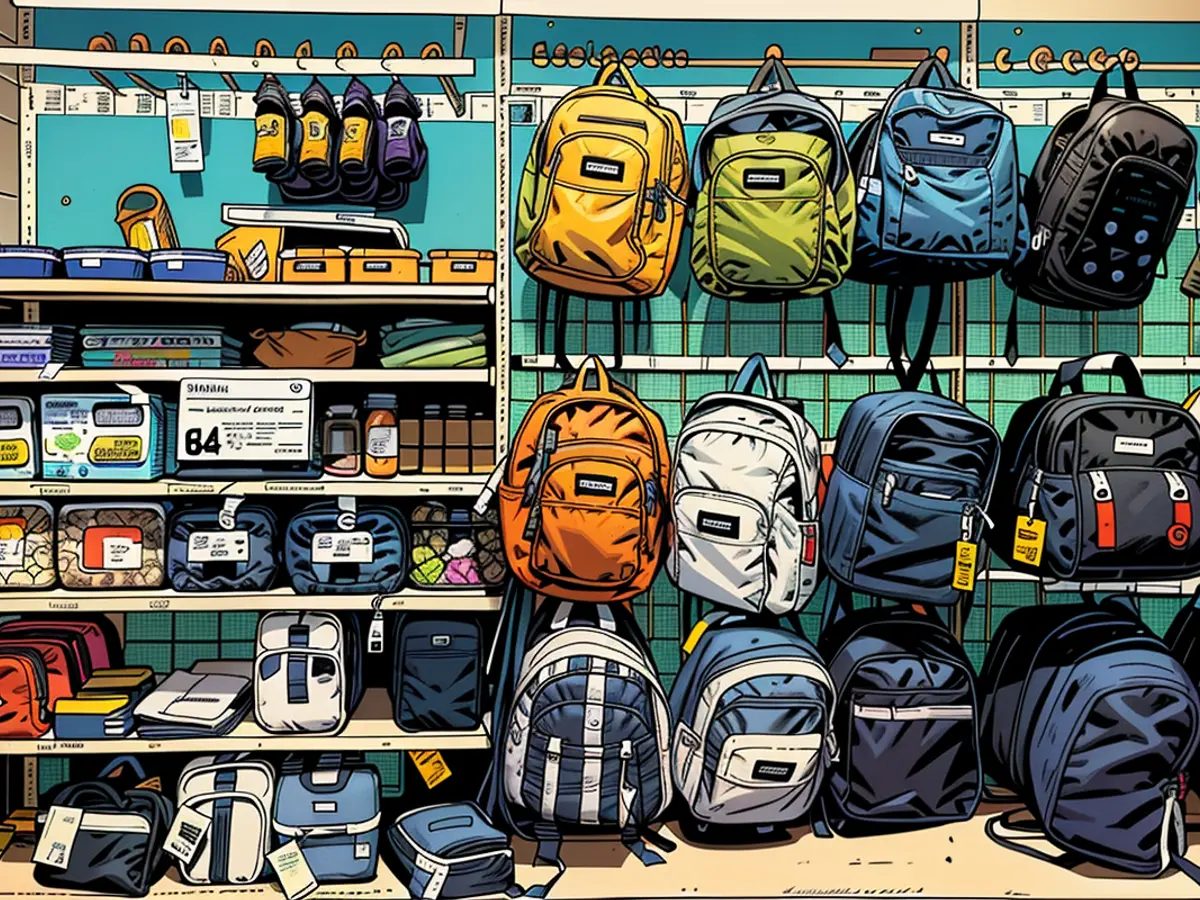This year, expected expenditure on back-to-school purchases by Americans amounts to a staggering $39 billion.
That substantial amount, surpassing $890 per household and amounting to more than $890 overall, outperformed 2021's record by approximately 12%. Higher prices indeed played a role, yet so did an enhanced optimism towards the robust labor market, coupled with decelerating inflation and the resilient US economy.
This year, consumers have become more cautious. Although inflation, while higher than usual, is almost extinguished, consumers have started to tighten their belts as they confront the cumulative effects of price hikes and navigate through an anticipated yet unsettling economic decline.
However, there's still enough groundwork to anticipate 2024's back-to-school spending to be the second-highest on record, reaching $38.8 billion, or $874.68 per household.
The extent to which this forecast holds true could serve as a significant indicator, signifying not just how consumers are adjusting their spending habits, but also the overall state of the consumer-driven economy.
As Mark Mathews, NRF's executive director of research, explained to CNN, "There still seems to be quite a lot of intent to go out and spend."
Consumers have simply become "extremely cost-conscious," he added.
Seeking bargains and reduced expenses
In regular circumstances, items like stationery, apparel, and electronics would fall under the category of discretionary spending.
Nevertheless, it's the discretionary and more substantial purchases that have experienced the most significant drops during the spending downturn.
Back-to-school, however, is an exceptional case.
"Back to school is not a discretionary event; it's really essential spending," Mathews said. "If you're sending your kid off to college, you've got to buy furniture. You've got to buy shoes, because kids continue to grow."
Although consumers cannot eliminate essential spending, they can scale back; NRF studies have revealed that nearly 41% of respondents are on the lookout for deals.
"Consumers are definitely out there searching for sales," he said. "Retailers recognize that, with price-conscious consumers, you really have to be promotional."
The shifting dynamics of inflation are likely contributing to these developments. While the rate of price increases has stayed persistently higher than usual, it's been categories such as services and particularly housing-related services that have supplied the upward pressure, Consumer Price Index data confirms.
Improved operational efficiency in supply chains and consumers shifting their spending towards services and experiences have helped goods categories to witness disinflation (prices rising but at a reduced pace) or even deflation (prices falling).
Retail prices are anticipated to decrease by 0.7% this year, following a 5.9% rise in 2022 and a 0.6% increase last year, as per a study from S&P Global Market Intelligence economists released recently.
Certain commonly-purchased school supplies are also less expensive than last year, and some are even below 2019 prices, according to monthly retail tracking data from Circana, a market research firm.
Sticky notes are down 22% from this time last year; paper is down 20%; and crayons and pencils are down 19% and 13%, respectively. Crayons and self-stick notes are even down from 2019, declining by 7% and 12% (while other categories have at least risen by 11%), Circana data shows.
Remnants of optimism
Average hourly and weekly earnings have been above inflation for over a year, Bureau of Labor Statistics data suggests, driving consumer spending growth.
As a result, back-to-school spending volumes are likely to remain relatively consistent with last year, according to Duleep Rodrigo, KPMG's US consumer and retail sector leader.
"What surprised us was that we saw some more positive sentiments from consumers regarding fall shopping," Rodrigo informed CNN in an interview.
Concerning the most recent consumer survey, he noted a turnaround, with many instances showing a reversal from the summer survey's grim outlook. He attributed this upturn to "higher expectations around interest rate cuts" and discounts.
It may also have favorable implications for the all-important holiday shopping season, he suggested.
"They're much more optimistic in spending," he said.
'I'm hunting for bargains'
For several families, spending, particularly back-to-school spending, is experiencing a significant transformation compared to past experiences.
In Shoreline, Washington, Amanda Webber and her family have been making financial adjustments for some time now.
Most of the family's savings have been devoted to covering the medical expenses related to Webber's brain surgery earlier this year. She is recovering well and is expected to return to work soon, but the monthly budget has been affected.
As a result, the family has been cutting costs by shopping at Costco, purchasing in bulk from the butcher, preparing meals well in advance, and reducing electricity usage by turning off the air conditioner.
Back-to-school spending is no exception to the thriftiness rule.
"I'm hunting for bargains," Webber said, noting her strategies include locating coupons online, carrying out more price comparisons, delving into clearance sections, and participating in her neighborhood's "buy nothing" group.
She and her husband even extracted sheets from the black-and-white marbled composition books they had on hand to reuse them.
As a result, the actual money spent has been focused on acquisitions, like buying an interview- and presentation-ready outfit for their 16-year-old daughter, Webber said.
"The costliest items were the shoes," said Webber, 49.
A shift in spending practices
In Gainesville, Florida, Lisa Castruita, 46, and her daughter adhere to a straightforward credo: "Do more with less, or make do with what you have."
"Folks need to be sensible with their actions and decisions," Castruita shared with CNN. "People in the past, they managed to achieve a lot with very little."
The pandemic and the subsequent personal and financial shifts it brought about had a significant impact on Castruita, who lost her husband to Covid in 2021.
"Previously, I had support and more income, so I didn't think twice about splurging on new items, like new notebooks, always choosing the top-notch ones," she said. "But as a single parent or a one-income family, you really feel it when prices skyrocket. I'm a widow now, and I feel like I've had no other choice but to approach things more thoughtfully and cautiously."
With her daughter starting 11th grade, Castruita expressed her intention to avoid the excessive spending typical of back-to-school seasons in the past.
"I observed that we often end up needlessly spending and racking up debt," she said. "I would buy stuff and half of it would sit unused. I'm a widow now, and I just feel like I don't have the luxury to do that anymore."
Besides being resourceful, shopping at thrift stores, and snatching deals, Castruita revealed that her network of friends and family, who she affectionately calls her "tribe," have been instrumental in helping her save money. They've offered her gently used clothing, a haircut, and even a backpack without charging any money, or in exchange for favors.
As a result, Castruita estimates that she's reduced her retail spending by about 60-70% for this back-to-school season compared to previous years. And by cutting down on unnecessary expenses, she can allocate funds towards creating memorable experiences with her daughter, she said.
"The current economic climate doesn't allow for the extravagances we once enjoyed," she said. "It's about adjusting our lifestyles. It's about making smart, rational, practical decisions that will enhance our quality of life."
Despite the current economic uncertainty, retail prices for some commonly-purchased school supplies are anticipated to decrease this year, according to S&P Global Market Intelligence economists. This is good news for families like the Webber’s in Shoreline, Washington, who are consciously watching their spending and looking for bargains to make their back-to-school budget go further. Moreover, businesses recognizing the cost-consciousness of consumers are becoming increasingly promotional to attract sales, demonstrating the impact of the economy on both consumer behavior and business strategies.









